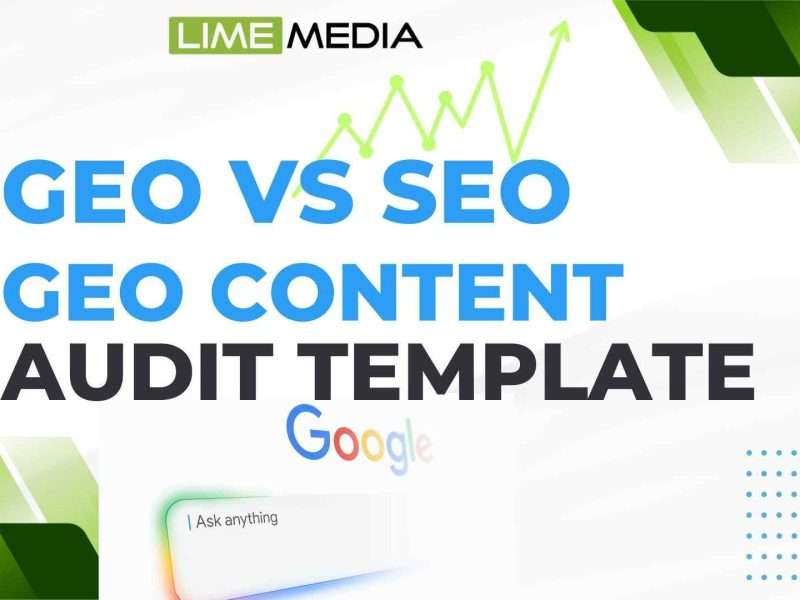Your Old SEO Checklist Won’t Cut It – Try This GEO Content Audit Template Instead
As you all know, in the modern era, searches are changing very fast, and the old SEO checklist is no longer enough today. Now, Generative Engine Optimization, aka GEO, has taken center stage, and if you want your website or brand to be recognized as a trusted source for AI platforms, then you need to adapt to GEO.
In the world of SEO, you need to know that the best GEO strategies are not flashy tricks, but they are quiet tweaks, edits, and formatting choices to make AI models pull your content naturally. You don’t need to shout about this.
At LimeMedia.org, I’ve just created a GEO Content Audit Template, which is in the style of an improved version of a traditional SEO audit. I present to you the “offline” version of SEO, with the same results we all aim for, but simplified, rethought, and very personal.
Here is an explanation of how the template works and what you can do with it to stay ahead.
Table of Contents
Use This GEO Content Audit Template
When you make a copy of the GEO audit Template, you can work through a few key sheets.
- Summary: A high-level view after scoring the checklist.
- Action list: Here is what we will do next will be in the action list.
- Content inventory: The core of your audit. It includes filters like:
- URL
- Page title
- Author
- Action
- Strategy
- Canonicals
- Word count & readability
- Average words per sentence
- Internal links
- Keywords
- Last updated date
- Strategy/action to take
- Indexability and architecture: Technical elements such as URL structure and On-Page configuration.
- Structured data: Schema markup tags you still need.
- International: Herflang, Translation between languages, language indicators, and local trust factors.
- Speed: Page speed optimization is still an important factor.
- Content and gaps: Quality assessment and what’s missing. Also, you need to put first-person content.
- Linking: Internal links and external targets.
- Refresh schedules: How often do we update different assets?
You will see yourself jumping between the content inventory, structured data, content gaps, and linking tabs.
Tools You’ll Find Handy
- For crawling & gaps: Screaming Frog, Ahrefs, or Semrush.
- For keyword tracking: Google Search Console with a regex brand filter.
- For AI prompt testing: ChatGPT, Google AI Overviews, Gemini, Perplexity, and Copilot. Log when your brand is included or cited.
- For attribution: Tools like Roadway AI, Zoho, HubSpot, or GHL to connect topics/pages to real revenue.
How to Do a GEO Content Audit (Step by Step)
In this section, I’ll guide you step by step through the GEO content Audit, so stay focused.
1. Set out your Goals clearly
Determine what results you will follow up on, such as:
- Inclusion rate: How frequently your brand is brought up in AI responses.
- Homepage/direct lift: Tracking that users go from AI – Google – your homepage.
- Revenue by topic/page: Tracking what products from which categories are selling.
Pro move: Add ChatGPT/AI Search as an option in your forms. “How did you hear about us? We see this as a way to report on where AI-assisted discovery is taking place.
2. Develop Your Content Library
You need to develop your content by putting the following information: Title, Headline, Author, word count, readability, and internal links.
Add custom fields such as:
- Direct answer present? (Y/N)
- FAQ present? (Y/N)
Note: Pages that are tidy, answer first, and FAQ rich are much easier for AI to process.
3. Segment By Site, Market and Language.
Divide your inventory into:
- Domains/subdomains/folders.
- Language differences (U.S. vs. U.K. English, Spain vs. Mexico Spanish).
- Indexing issues (dups, parameters, session IDs).
For international pages, always check:
- Hreflang setup.
- Local indicators, which include spelling, currency, trust marks, and VAT info.
- Local CTAs and numbers.
4. Fetch the Numbers.
Don’t only focus on organic traffic. Also check:
- Organic sessions and conversions.
- Direct homepage visits.
- GSC stats for brand filtered queries.
- AI mentions reports (what engine included you, for which prompt).
Google reports AI performance is better, but many SEO teams report a drop in total traffic. See for yourself what is true in your case.
5. Assess the Substance
Rate all high-value pages on citable elements or signals:
- A brief short answer (<120 words).
- Proprietary information, expert statements, and external links.
- Trade-off scenarios (in which your product may not be the best fit).
- FAQ structures that mirror the real prompt syntax.
- Schema markup (FAQ, How To, Product, Author, etc).
6. Map Issues and Disputes.
Create a list of issues which are causing the conflicts:
- Duplicates/cannibalization → Merge or redirect.
- Missing out on BOFU pages, which should include “Competitor alternatives, “X vs. Y, and pricing guides.
- Offsite presence, which means to say that you should be present on comparison sites, review hubs, Reddi,t and YouTube.
Note: AI uses this, which is why the more you have your brand out there, the better your chances.
7. Outline Action Plan
Develop a clear action plan for all.
- Fixes: Language, which also includes Hreflang, use of canonical tags, FAQ schema, and direct answer summaries.
- Net-new assets: Alternative pages, price breakdowns, video guides, local FAQs.
- Earned mentions: Present your data-led stories to publishers, also put forth for review, and get involved in community discussions.
- Attribution setup: Connect that all with revenue in HubSpot, Zoho, or GHL.
Worked Example: Filling the Template
Worked Example: Filling out the Template.
- Goal: You need to add 4 out of 5 prompts in AI answers.
- Load the most popular 100 URLs, tag as keep, update, merge, or redirect.
- Add FAQs and schema.
- Check hreflang for local signals.
- List out what is missing in the BOFU stage and prioritize.
- Add in links from high-traffic pages.
- Track AI progress weekly (as results fluctuate with Google and AI changes).
Keep These Moves in Mind
Refresh rate:
- Fast growing sectors like SaaS/finance, quarterly.
- Slower moving niches, biannual or annual.
Local beats translation: U.K. is not U.S., Spain is not Mexico.
Track what matters: Inclusion of brands, which includes regex impressions, home page lift, and revenue by topic/page. We don’t put much stock in LLM rankings.
GEO vs. SEO: What is the Difference?
- SEO Audit which looks at rankings, traffic, indexing, and structure.
- GEO Audit: We look at how your content is cited by AI models.
Both are true. SEO increases your visibility; at the same time, GEO proves to AI platforms that you are a trusted and relevant source.
GEO is Here to Stay
As I already mentioned, visibility is changing. AI is the star of the show now on Search Engines, and if your brand isn’t getting visibility on AI platforms, it means you’re missing out. Als,o your competitors may get mentioned without beating you in search results.
Your job: Be the source from which AI reports.
So perform the audit, strengthen your structure, add in the proof, get those mentions, and most of all, tie it to revenue. That’s what will future-proof your content strategy.
Do you want your brand included in AI responses?
At LimeMedia.org, we support businesses with audit, improvement and structure of their content for SEO and GEO, and became the best SEO and GEO Company in Lahore. From technical setup to conversion tracking and offsite presence, we see to it that you are and always will be at the front of the AI’s mind, and also a key focus for growth. Reach out to Lime Media now to get started with your GEO content audit and be at the front of the pack.



